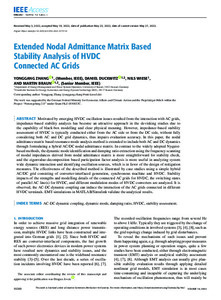| dc.date.accessioned | 2022-08-29T10:05:47Z | |
| dc.date.available | 2022-08-29T10:05:47Z | |
| dc.date.issued | 2022-05-23 | |
| dc.identifier | doi:10.17170/kobra-202208296772 | |
| dc.identifier.uri | http://hdl.handle.net/123456789/14109 | |
| dc.description.sponsorship | Gefördert durch den Publikationsfonds der Universität Kassel | ger |
| dc.language.iso | eng | |
| dc.rights | Namensnennung 4.0 International | * |
| dc.rights.uri | http://creativecommons.org/licenses/by/4.0/ | * |
| dc.subject | AC-DC dynamic coupling | eng |
| dc.subject | dynamic mode | eng |
| dc.subject | damping ratio | eng |
| dc.subject | HVDC | eng |
| dc.subject | stability assessment | eng |
| dc.subject.ddc | 333 | |
| dc.title | Extended Nodal Admittance Matrix Based Stability Analysis of HVDC Connected AC Grids | eng |
| dc.type | Aufsatz | |
| dcterms.abstract | Motivated by emerging HVDC oscillation issues resulted from the interaction with AC grids, impedance-based stability analysis has become an attractive approach in the de-risking studies due to the capability of black-box modelling and clear physical meaning. However, impedance-based stability assessment of HVDC is typically conducted either from the AC side or from the DC side, without fully considering both AC and DC grid dynamics, thus impairs evaluation accuracy. In this paper, the nodal admittance matrix based resonance mode analysis method is extended to include both AC and DC dynamics through formulating a hybrid AC/DC nodal admittance matrix. In contrast to the widely adopted Nyquist-based methods, the dynamic mode identification and damping ratio extraction using the frequency scanning of modal impedances derived from nodal admittance matrix is more straightforward for stability check, and the eigenvalue-decomposition based participation factor analysis is more useful in analyzing system wide dynamic interaction and identifying oscillation sources, which is in favor of the design of mitigation measures. The effectiveness of the described method is illustrated by case studies using a simple hybrid AC/DC grid consisting of converter-interfaced generation, synchronous machine and HVDC. Stability impacts of the strengths and modelling details of the connected AC grids for HVDC, the switching states of parallel AC line(s) for HVDC, and different modulation modes of HVDC converters are analyzed. It is observed, the AC-DC dynamic coupling can induce the interaction of the AC grids connected in different HVDC terminals. EMT-simulations in MATLAB/Simulink validate the analytical results. | eng |
| dcterms.accessRights | open access | |
| dcterms.creator | Zhang, Yonggang | |
| dcterms.creator | Duckwitz, Daniel | |
| dcterms.creator | Wiese, Nils | |
| dcterms.creator | Braun, Martin | |
| dc.relation.doi | doi:10.1109/ACCESS.2022.3177232 | |
| dc.subject.swd | Hochspannungsgleichstromübertragung | ger |
| dc.subject.swd | Dämpfung | ger |
| dc.subject.swd | Erneuerbare Energien | ger |
| dc.subject.swd | Elektrizitätsversorgungsnetz | ger |
| dc.subject.swd | Wechselstrom | ger |
| dc.subject.swd | Gleichstrom | ger |
| dc.subject.swd | Schwingung | ger |
| dc.subject.swd | Nyquist-Kriterium | ger |
| dc.subject.swd | SIMULINK | ger |
| dc.subject.swd | MATLAB | ger |
| dc.type.version | publishedVersion | |
| dcterms.source.identifier | eissn:2169-3536 | |
| dcterms.source.journal | IEEE Access | eng |
| dcterms.source.pageinfo | 55200-55212 | |
| dcterms.source.volume | Volume 10 | |
| kup.iskup | false | |


